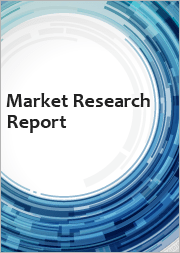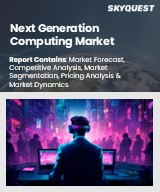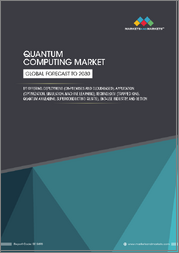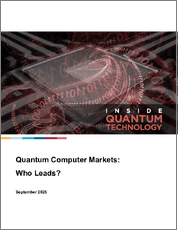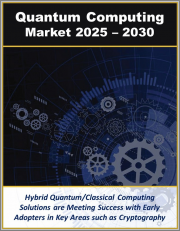
|
시장보고서
상품코드
1698614
세계의 양자 컴퓨팅 시장 : 기술, 인프라, 서비스, 산업별(2025-2030년)Quantum Computing Market by Technology, Infrastructure, Services, and Industry Verticals 2025 - 2030 |
||||||
이 조사 보고서는 양자 컴퓨팅이 촉진하는 기술, 조직, R&D 노력 및 잠재적 솔루션을 평가합니다.
이 보고서는 양자 컴퓨팅이 하드웨어, 소프트웨어, 용도, 서비스 등의 인프라에 미치는 영향에 대한 2025년부터 2030년까지 세계 및 지역 예측 및 전망을 보여줍니다.
분석에는 모든 주요 산업에서 양자 컴퓨팅 시장이 포함되어 있으며, 양자 컴퓨팅이 촉진하는 기술, 기업/조직, R&D 활동 및 잠재적인 솔루션을 평가합니다.
조사 결과 발췌:
- 2024년 세계 양자 컴퓨팅 시장 규모는 18억 5,600만 달러에 도달
- 2030년까지 시장 전체는 CAGR 28.7%로 성장하여 74억 8,400만 달러에 달할 전망
- 2024년에는 하드웨어가 시장 전체의 61%를 차지한 최대 부문
- 초전도(냉각) 루프 방식이 최대의 기술 부문으로, 2024년 시장 전체의 38.3%를 차지하는 한편, 토폴로지컬 양자 비트는 2024-2030년의 CAGR이 33.9%로 가장 높은 성장을 나타낼 것으로 전망
- 북미가 최대의 지역이며, 2024년 점유율은 전체의 33.6%
- 북미에서는 미국이 최대국이며, 유럽에서는 독일, 프랑스, 영국, 러시아가 주요국
- 아시아태평양은 2024-2030년간 CAGR 27.9%로 가장 높은 성장을 보여줄 전망
양자 컴퓨팅의 클록 속도는 빠르지 않지만, 지수 함수적으로 큰 데이터 세트를 다루는 것으로, 특정의 문제에 대해서는 고전적인 컴퓨팅보다 훨씬 고속으로 처리할 수 있습니다. 사이버 보안이나 암호화 통화와 같이, 고전적인 컴퓨터에서는 시간이 걸리는 소인수분해에 의존하는 분야에서는 이 시장은 유리한 입장에 있습니다.
양자 컴퓨팅에는 다양한 과제가 남아 있지만, 다양한 산업과 용도에 미래가 유망시되고 있으며, 처음에는 암호, 데이터 사이언스, 재료과학, 분자 물리 등의 연구 분야를 지원합니다. 이러한 분야에서의 혁신은 항공, 사이버 보안, 금융 서비스, 헬스케어 등의 분야에서 가치를 높일 것으로 예상되며, 양자화학은 신약개발에 혁명을 일으킬 수 있습니다.
목차
제1장 주요 요약
제2장 소개
- 양자 컴퓨팅 이해
- 양자 컴퓨터의 유형
- 양자 어닐라
- 아날로그 양자
- 보편 양자
- 양자 컴퓨팅과 기존 컴퓨팅
- 기존 컴퓨팅이 대체될까?
- 물리 양자 비트와 논리 양자 비트
- 개발 타임라인
- 시장 요인
- 개발의 진척
- 양자 비트수 증가
- 새로운 유형의 양자 비트 개발
- 특허 분석
- 규제 분석
- 파괴적 변화와 기업 준비 가이드라인
제3장 양자 컴퓨팅: 기술 및 시장 분석
- 업계의 현상
- 기술 스택
- 양자 컴퓨팅과 AI
- 양자 뉴런
- 양자 컴퓨팅과 빅데이터
- 선형 광양자 컴퓨팅
- 양자 컴퓨팅의 비즈니스 모델
- 양자 소프트웨어 플랫폼
- 응용 분야
- 신흥 수익 부문
- 투자분석
- 양자 컴퓨팅 이니셔티브 : 국가별
- 미국
- 캐나다
- 멕시코
- 브라질
- 영국
- 프랑스
- 러시아
- 독일
- 네덜란드
- 덴마크
- 스웨덴
- 사우디아라비아
- UAE
- 카타르
- 쿠웨이트
- 이스라엘
- 호주
- 중국
- 일본
- 인도
- 싱가포르
제4장 양자 컴퓨팅: 시장 개요
- 기존 컴퓨팅과 양자 컴퓨팅의 차이
- 양자 컴퓨팅의 접근
- 각 유형의 기업이 양자 우위성에 대비하는 방법
- 양자 컴퓨팅에 관한 정부의 대처와 계획
- 양자 비즈니스에서의 전략적 시책
- 양자 컴퓨팅이 향후 사업계획에 미치는 영향
제5장 양자 컴퓨팅: 촉진요인과 과제
- 시장 역학
- 시장 성장 촉진요인
- 항공우주 및 방위 분야에서의 적응 확대
- 정부 투자 증가
- 고도의 용도의 출현과 안전한 통신과 디지털화의 필요성
- 시장의 과제
- 알고리즘 개발
- 구현 및 운영과 관련된 문제
- 확장성과 관련된 문제
- 클래식 컴퓨팅과의 통합
제6장 양자 컴퓨팅: 이용 사례
- 의약품의 양자 컴퓨팅
- 양자기술을 금융문제에 응용한다
- 양자 AI로 자율주행차를 가속
- 양자 컴퓨팅을 활용하는 자동차 제조업체
- NASA 미션을 위한 고도의 컴퓨팅을 가속
제7장 양자 컴퓨팅 : 밸류체인 분석
- 양자 컴퓨팅의 밸류체인 구조
- 양자 컴퓨팅의 경쟁 분석
- 대규모 컴퓨팅 시스템
제8장 양자 컴퓨팅 기업 분석
- D-Wave Systems Inc.
- Google Inc.
- Microsoft Corporation
- IBM Corporation
- Intel Corporation
- Nokia Corporation
- Toshiba Corporation
- Raytheon Company
- 기타 기업
- 1QB Information Technologies Inc.(IQbit)
- Cambridge Quantum Computing Ltd.(CQC)
- QC Ware Corp.
- MagiQ Technologies Inc.
- Rigetti Computing
- Anyon Systems Inc.
- Quantum Circuits Inc.
- Hewlett Packard Enterprise
- Fujitsu Ltd.
- NEC Corporation
- SK Telecom
- Lockheed Martin Corporation
- NTT Docomo Inc.
- Alibaba Group Holding Limited
- Booz Allen Hamilton Inc.
- Airbus Group
- Amgen Inc.
- Biogen Inc.
- BT Group
- Mitsubishi Electric Corp.
- Volkswagen AG
- KPN
- 에코시스템 공헌자
- Agilent Technologies
- Artiste-qb.net
- Avago Technologies
- Ciena Corporation
- Eagle Power Technologies Inc
- Emcore Corporation
- Enablence Technologies
- Entanglement Partners
- Fathom Computing
- Alpine Quantum Technologies GmbH
- Atom Computing
- Black Brane Systems
- Delft Circuits
- EeroQ
- Everettian Technologies
- EvolutionQ
- H-Bar Consultants
- Horizon Quantum Computing
- ID Quantique(IDQ)
- InfiniQuant
- IonQ
- ISARA
- KETS Quantum Security
- Magiq
- MDR Corporation
- Nordic Quantum Computing Group(NQCG)
- Oxford Quantum Circuits
- Post-Quantum(PQ Solutions)
- ProteinQure
- PsiQuantum
- Q&I
- Qasky
- QbitLogic
- Q-Ctrl
- Qilimanjaro Quantum Hub
- Qindom
- Qnami
- QSpice Labs
- Qu & Co
- Quandela
- Quantika
- Quantum Benchmark Inc.
- Quantum Circuits Inc.(QCI)
- Quantum Factory GmbH
- QuantumCTek
- Quantum Motion Technologies
- QuantumX
- Qubitekk
- Qubitera LLC
- Quintessence Labs
- Qulab
- Qunnect
- QuNu Labs
- River Lane Research(RLR)
- SeeQC
- Silicon Quantum Computing
- Sparrow Quantum
- Strangeworks
- Tokyo Quantum Computing(TQC)
- TundraSystems Global Ltd.
- Turing
- Xanadu
- Zapata Computing
- Accenture
- Atos Quantum
- Baidu
- Northrop Grumman
- Quantum Computing Inc.
- Keysight Technologies
- Nano-Meta Technologies
- Optalysys Ltd.
- Quentum
- III-V Epi QC Design
- Arque
- Xeed
- Waves of Silence
- Quobly
- eleQtron Delft
- C12
- ORCA Computing
- OGC Devil Quantum
- QDevil
- Pasqal
- Kelvin Nanotechnology
- Oxford Ionica
- IQM
- Quantum Mechanics
- Quantum Brilliance
- Alpine Quantum Technologies
- Iqrypto
- TQ Audacy
- Mercury Dynamics
- Quantum Numbers
- QuBalt
- Arqit Quantum
- Quantum Security
- ID Quantique
- SECQAI
- Qurypto
- CryptoNext Security
- Photon Force
- Micro Photon Devices
- Single Quantum
- TACEO
- CyberHive
- PQShield
- Quanticor
- Adamant Quantum
- Sallience Labs
제9장 양자 컴퓨팅 시장의 분석·예측
- 양자 컴퓨팅 시장 : 인프라별
- 양자 컴퓨팅 시장 : 기술 부문별
- 양자 컴퓨팅 시장 : 산업별
- 양자 컴퓨팅 시장 : 지역별
제10장 총론·제안
제11장 부록: 양자 컴퓨팅 및 기존 HPC
- 차세대 컴퓨팅
- 양자 컴퓨팅과 기존의 고성능 컴퓨팅
- 고성능 컴퓨팅의 AI
- 엑사 스케일 컴퓨팅의 양자 기술 시장
숫자:
표:
JHS 25.04.21Overview:
This quantum computing market report assesses the technology, organizations, R&D efforts, and potential solutions facilitated by quantum computing.
The report provides global and regional forecasts as well as the outlook for quantum computing impact on infrastructure including hardware, software, applications, and services from 2025 to 2030.
Analysis includes the quantum computing market across all major industry verticals. It also assesses technology, companies/organizations, R&D efforts, and potential solutions facilitated by quantum computing.
Select Report Findings:
- The market for global quantum computing in the year 2024 reached $1,856 million
- Mind Commerce estimates that by the year 2030, the overall market will grow by a CAGR of 28.7% to reach $7,484 million
- Hardware is the largest segment with 61% of the total market in 2024
- The superconducting (Cooling) loop method is the largest technology segment with 38.3% of the total market in 2024. Topological qubit is expected to have the highest growth with a CAGR of 33.9% during 2024 to 2030
- North America is the largest region with 33.6% of the total market in 2024
- USA is the largest country in the North America, while Germany, France, UK, and Russia are major countries in Europe
- Asia Pacific is expected to have the highest growth with a CAGR of 27.9% during 2024 to 2030
Quantum computing is a theoretical computational system based on quantum theory, dealing with nanoscale physical phenomena. A key aspect is the quantum bit (qubit), a unit of quantum information that exists in multiple states simultaneously due to the superposition principle.
Unlike classical bits, which are either 0 or 1, qubits' simultaneous multi-state nature allows for significantly faster processing for certain problems. This has major implications for data processing, communications, digital commerce and security, and the internet.
The quantum computing market includes platforms, processors, and chipsets relying on quantum theory at the nanoscale. The qubit's superposition enables simultaneous existence in multiple states.
While not having a faster clock speed, quantum computing is much faster than classical computing for specific problems by handling exponentially larger datasets. The market is well-positioned for areas like cybersecurity and cryptocurrencies that depend on prime factoring, a time-consuming task for classical computers.
Despite the hype, quantum computing will initially complement classical High-Performance Computing (HPC) for most general tasks, with HPC potentially used for initial problem setup. Quantum computing excels at problems with many possible outcomes, such as molecular modeling in materials science, where classical computing struggles. Conversely, it faces challenges with problems involving many input/output iterations, necessitating HPC assistance.
Quantum computing platforms have physical constraints, often requiring a vacuum and cryogenic cooling for superconductivity to prevent decoherence. Current systems also need error checking.
Presently, quantum computers are typically purpose-built for specific problems and algorithms like Grover's for unstructured search and Shor's for prime factoring, supporting big data analytics and cybersecurity, respectively.
Unlike software-updatable classical computers, quantum computers often require hardware adaptation for different algorithms, meaning distinct quantum computers might be needed for tasks like big data analytics versus cybersecurity.
Different methods exist for building quantum computers based on how qubits are created (electrons, photons, superconducting magnets), leading to platform variations like Ion Trap, Nuclear Magnetic Resonance, Optical Method, Quantum Annealing, Quantum Dot Computing, Superconducting, and Topological methods.
Despite challenges, quantum computing has a promising future in various industries and applications, initially supporting research areas like cryptography, data science, materials science, and molecular physics. Breakthroughs in these fields are expected to drive value in sectors such as aviation, cybersecurity, financial services, and healthcare, with quantum chemistry potentially revolutionizing drug discovery.
The technology is rapidly advancing. For example, a Chinese research team has recently employed their indigenously developed 72-qubit Origin Wukong quantum computer to fine-tune a massive AI model containing a billion parameters. This process led to enhanced model performance despite a parameter reduction exceeding 75%, signifying significant progress in the convergence of quantum computing and sophisticated AI applications.
The researchers used Origin Wukong to fine-tune a billion-parameter model in one experiment. This resulted in a 15% decrease in training loss on a psychological counseling dialogue dataset, a significant indicator of improved learning. Furthermore, the model's accuracy on a mathematical reasoning task increased substantially from 68% to 82%.
Mind Commerce anticipates many additional advances in the field of quantum computing, ultimately leading to certain computing tasks becoming quantum-centric rather than relying upon classical computing. As a preparatory measure, we encourage all industry verticals to adopt a hybrid quantum/classical policy now, with an emphasis on certain key areas such as encryption. Current public-key cryptography (PKC) algorithms like RSA and ECC, which underpin much of modern digital security (including TLS/SSL, SSH, and digital signatures), will become vulnerable to quantum computers running Shor's algorithm.
Table of Contents
1.0. Executive Summary
2.0. Introduction
- 2.1. Understanding Quantum Computing
- 2.2. Quantum Computer Types
- 2.2.1. Quantum Annealer
- 2.2.2. Analog Quantum
- 2.2.3. Universal Quantum
- 2.3. Quantum Computing vs. Classical Computing
- 2.3.1. Will Quantum replace Classical Computing?
- 2.3.2. Physical Qubits vs. Logical Qubits
- 2.4. Quantum Computing Development Timeline
- 2.5. Quantum Computing Market Factors
- 2.6. Quantum Computing Development Progress
- 2.6.1. Increasing the Number of Qubits
- 2.6.2. Developing New Types of Qubits
- 2.7. Quantum Computing Patent Analysis
- 2.8. Quantum Computing Regulatory Analysis
- 2.9. Quantum Computing Disruption and Company Readiness Guideline
3.0. Quantum Computing Technology and Market Analysis
- 3.1. Quantum Computing State of the Industry
- 3.2. Quantum Computing Technology Stack
- 3.3. Quantum Computing and Artificial Intelligence
- 3.4. Quantum Neurons
- 3.5. Quantum Computing and Big Data
- 3.6. Linear Optical Quantum Computing
- 3.7. Quantum Computing Business Model
- 3.8. Quantum Software Platform
- 3.9. Application Areas
- 3.10. Emerging Revenue Sectors
- 3.11. Quantum Computing Investment Analysis
- 3.12. Quantum Computing Initiatives by Country
- 3.12.1. USA
- 3.12.2. Canada
- 3.12.3. Mexico
- 3.12.4. Brazil
- 3.12.5. UK
- 3.12.6. France
- 3.12.7. Russia
- 3.12.8. Germany
- 3.12.9. Netherlands
- 3.12.10. Denmark
- 3.12.11. Sweden
- 3.12.12. Saudi Arabia
- 3.12.13. UAE
- 3.12.14. Qatar
- 3.12.15. Kuwait
- 3.12.16. Israel
- 3.12.17. Australia
- 3.12.18. China
- 3.12.19. Japan
- 3.12.20. India
- 3.12.21. Singapore
4.0. Quantum Computing Market Overview
- 4.1. What Distinguishes Classical and Quantum Computing?
- 4.2. Approaches of Quantum Computing
- 4.3. How Each Type of Player Can Prepare for Quantum Advantage
- 4.4. Government Initiatives and Plan on Quantum Computing
- 4.5. Measures to Take Strategically in Quantum Business
- 4.6. Quantum Computing's Effect on Upcoming Business Plans
5.0. Quantum Computing Drivers and Challenges
- 5.1. Quantum Computing Market Dynamics
- 5.2. Quantum Computing Market Drivers
- 5.2.1. Growing Adaption in Aerospace and Defense Sector
- 5.2.2. Growing Investment of Governments
- 5.2.3. Emergence of Advance Applications and the Need for Secure Communication and Digitization
- 5.3. Quantum Computing Market Challenges
- 5.3.1. Algorithm Development
- 5.3.2. Problems Associated with Implementation and Operations
- 5.3.3. Problems Associated with Scalability
- 5.3.4. Integration with Classical Computing
6.0. Quantum Computing Use Cases
- 6.1. Quantum Computing in Pharmaceuticals
- 6.2. Applying Quantum Technology to Financial Problems
- 6.3. Accelerate Autonomous Vehicles with Quantum AI
- 6.4. Car Manufacturer using Quantum Computing
- 6.5. Accelerating Advanced Computing for NASA Missions
7.0. Quantum Computing Value Chain Analysis
- 7.1. Quantum Computing Value Chain Structure
- 7.2. Quantum Computing Competitive Analysis
- 7.2.1. Leading Vendor Efforts
- 7.2.2. Start-up Companies
- 7.2.3. Government Initiatives
- 7.2.4. University Initiatives
- 7.2.5. Venture Capital Investments
- 7.3. Large Scale Computing Systems
8.0. Quantum Computing Company Analysis
- 8.1. D-Wave Systems Inc.
- 8.1.1. Company Overview:
- 8.1.2. Product Portfolio
- 8.1.3. Recent Developments
- 8.2. Google Inc.
- 8.2.1. Company Overview:
- 8.2.2. Product Portfolio
- 8.2.3. Recent Developments
- 8.3. Microsoft Corporation
- 8.3.1. Company Overview:
- 8.3.2. Product Portfolio
- 8.3.3. Recent Developments
- 8.4. IBM Corporation
- 8.4.1. Company Overview:
- 8.4.2. Product Portfolio
- 8.4.3. Recent Developments
- 8.5. Intel Corporation
- 8.5.1. Company Overview
- 8.5.2. Product Portfolio
- 8.5.3. Recent Developments
- 8.6. Nokia Corporation
- 8.6.1. Company Overview
- 8.6.2. Product Portfolio
- 8.6.3. Recent Developments
- 8.7. Toshiba Corporation
- 8.7.1. Company Overview
- 8.7.2. Product Portfolio
- 8.7.3. Recent Developments
- 8.8. Raytheon Company
- 8.8.1. Company Overview
- 8.8.2. Product Portfolio
- 8.8.3. Recent Developments
- 8.9. Other Companies
- 8.9.1. 1QB Information Technologies Inc. (IQbit)
- 8.9.1.1. Company Overview
- 8.9.1.2. Developments
- 8.9.2. Cambridge Quantum Computing Ltd. (CQC)
- 8.9.2.1. Company Overview
- 8.9.2.2. Developments
- 8.9.3. QC Ware Corp.
- 8.9.3.1. Company Overview
- 8.9.3.2. Developments
- 8.9.4. MagiQ Technologies Inc.
- 8.9.4.1. Company Overview
- 8.9.5. Rigetti Computing
- 8.9.5.1. Company Overview
- 8.9.5.2. Developments
- 8.9.6. Anyon Systems Inc.
- 8.9.6.1. Company Overview
- 8.9.7. Quantum Circuits Inc.
- 8.9.7.1. Company Overview
- 8.9.7.2. Developments
- 8.9.8. Hewlett Packard Enterprise
- 8.9.8.1. Company Overview
- 8.9.8.2. Developments
- 8.9.9. Fujitsu Ltd.
- 8.9.9.1. Company Overview
- 8.9.9.2. Developments
- 8.9.10. NEC Corporation
- 8.9.10.1. Company Overview
- 8.9.10.2. Developments
- 8.9.11. SK Telecom
- 8.9.11.1. Company Overview
- 8.9.11.2. Developments
- 8.9.12. Lockheed Martin Corporation
- 8.9.12.1. Company Overview
- 8.9.13. NTT Docomo Inc.
- 8.9.13.1. Company Overview
- 8.9.13.2. Developments
- 8.9.14. Alibaba Group Holding Limited
- 8.9.14.1. Company Overview
- 8.9.14.2. Developments
- 8.9.15. Booz Allen Hamilton Inc.
- 8.9.15.1. Company Overview
- 8.9.16. Airbus Group
- 8.9.16.1. Company Overview
- 8.9.16.2. Developments
- 8.9.17. Amgen Inc.
- 8.9.17.1. Company Overview
- 8.9.17.2. Developments
- 8.9.18. Biogen Inc.
- 8.9.18.1. Company Overview
- 8.9.18.2. Developments
- 8.9.19. BT Group
- 8.9.19.1. Company Overview
- 8.9.19.2. Developments
- 8.9.20. Mitsubishi Electric Corp.
- 8.9.20.1. Company Overview
- 8.9.21. Volkswagen AG
- 8.9.21.1. Company Overview
- 8.9.21.2. Developments
- 8.9.22. KPN
- 8.9.22.1. Developments
- 8.9.1. 1QB Information Technologies Inc. (IQbit)
- 8.10. Ecosystem Contributors
- 8.10.1. Agilent Technologies
- 8.10.2. Artiste-qb.net
- 8.10.3. Avago Technologies
- 8.10.4. Ciena Corporation
- 8.10.5. Eagle Power Technologies Inc
- 8.10.6. Emcore Corporation
- 8.10.7. Enablence Technologies
- 8.10.8. Entanglement Partners
- 8.10.9. Fathom Computing
- 8.10.10. Alpine Quantum Technologies GmbH
- 8.10.11. Atom Computing
- 8.10.12. Black Brane Systems
- 8.10.13. Delft Circuits
- 8.10.14. EeroQ
- 8.10.15. Everettian Technologies
- 8.10.16. EvolutionQ
- 8.10.17. H-Bar Consultants
- 8.10.18. Horizon Quantum Computing
- 8.10.19. ID Quantique (IDQ)
- 8.10.20. InfiniQuant
- 8.10.21. IonQ
- 8.10.22. ISARA
- 8.10.23. KETS Quantum Security
- 8.10.24. Magiq
- 8.10.25. MDR Corporation
- 8.10.26. Nordic Quantum Computing Group (NQCG)
- 8.10.27. Oxford Quantum Circuits
- 8.10.28. Post-Quantum (PQ Solutions)
- 8.10.29. ProteinQure
- 8.10.30. PsiQuantum
- 8.10.31. Q&I
- 8.10.32. Qasky
- 8.10.33. QbitLogic
- 8.10.34. Q-Ctrl
- 8.10.35. Qilimanjaro Quantum Hub
- 8.10.36. Qindom
- 8.10.37. Qnami
- 8.10.38. QSpice Labs
- 8.10.39. Qu & Co
- 8.10.40. Quandela
- 8.10.41. Quantika
- 8.10.42. Quantum Benchmark Inc.
- 8.10.43. Quantum Circuits Inc. (QCI)
- 8.10.44. Quantum Factory GmbH
- 8.10.45. QuantumCTek
- 8.10.46. Quantum Motion Technologies
- 8.10.47. QuantumX
- 8.10.48. Qubitekk
- 8.10.49. Qubitera LLC
- 8.10.50. Quintessence Labs
- 8.10.51. Qulab
- 8.10.52. Qunnect
- 8.10.53. QuNu Labs
- 8.10.54. River Lane Research (RLR)
- 8.10.55. SeeQC
- 8.10.56. Silicon Quantum Computing
- 8.10.57. Sparrow Quantum
- 8.10.58. Strangeworks
- 8.10.59. Tokyo Quantum Computing (TQC)
- 8.10.60. TundraSystems Global Ltd.
- 8.10.61. Turing
- 8.10.62. Xanadu
- 8.10.63. Zapata Computing
- 8.10.64. Accenture
- 8.10.65. Atos Quantum
- 8.10.66. Baidu
- 8.10.67. Northrop Grumman
- 8.10.68. Quantum Computing Inc.
- 8.10.69. Keysight Technologies
- 8.10.70. Nano-Meta Technologies
- 8.10.71. Optalysys Ltd.
- 8.10.72. Quentum
- 8.10.73. III-V Epi QC Design
- 8.10.74. Arque
- 8.10.75. Xeed
- 8.10.76. Waves of Silence
- 8.10.77. Quobly
- 8.10.78. eleQtron Delft
- 8.10.79. C12
- 8.10.80. ORCA Computing
- 8.10.81. OGC Devil Quantum
- 8.10.82. QDevil
- 8.10.83. Pasqal
- 8.10.84. Kelvin Nanotechnology
- 8.10.85. Oxford Ionica
- 8.10.86. IQM
- 8.10.87. Quantum Mechanics
- 8.10.88. Quantum Brilliance
- 8.10.89. Alpine Quantum Technologies
- 8.10.90. Iqrypto
- 8.10.91. TQ Audacy
- 8.10.92. Mercury Dynamics
- 8.10.93. Quantum Numbers
- 8.10.94. QuBalt
- 8.10.95. Arqit Quantum
- 8.10.96. Quantum Security
- 8.10.97. ID Quantique
- 8.10.98. SECQAI
- 8.10.99. Qurypto
- 8.10.100. CryptoNext Security
- 8.10.101. Photon Force
- 8.10.102. Micro Photon Devices
- 8.10.103. Single Quantum
- 8.10.104. TACEO
- 8.10.105. CyberHive
- 8.10.106. PQShield
- 8.10.107. Quanticor
- 8.10.108. Adamant Quantum
- 8.10.109. Sallience Labs
9.0. Quantum Computing Market Analysis and Forecasts 2025-2030
- 9.1.1. Quantum Computing Market by Infrastructure
- 9.1.1.1. Quantum Computing Market by Hardware Type
- 9.1.1.2. Quantum Computing Market by Application Software Type
- 9.1.1.3. Quantum Computing Market by Service Type
- 9.1.1.3.1. Quantum Computing Market by Professional Service Type
- 9.1.2. Quantum Computing Market by Technology Segment
- 9.1.3. Quantum Computing Market by Industry Vertical
- 9.1.4. Quantum Computing Market by Region
- 9.1.4.1. North America Quantum Computing Market by Infrastructure, Technology, Industry Vertical, and Country
- 9.1.4.1.1. Quantum Computing Market by Infrastructure
- 9.1.4.1.2. Quantum Computing Market by Hardware Type
- 9.1.4.1.3. Quantum Computing Market by Application Software Type
- 9.1.4.1.4. Quantum Computing Market by Service Type
- 9.1.4.1.4.1. Quantum Computing Market by Professional Service Type
- 9.1.4.1.5. Quantum Computing Market by Technology Segment
- 9.1.4.1.6. Quantum Computing Market by Industry Vertical
- 9.1.4.1.7. Quantum Computing Market by Country
- 9.1.4.2. European Quantum Computing Market by Infrastructure, Technology, and Industry Vertical
- 9.1.4.2.1. Quantum Computing Market by Infrastructure
- 9.1.4.2.2. Quantum Computing Market by Hardware Type
- 9.1.4.2.3. Quantum Computing Market by Application Software Type
- 9.1.4.2.4. Quantum Computing Market by Service Type
- 9.1.4.2.4.1. Quantum Computing Market by Professional Service Type
- 9.1.4.2.5. Quantum Computing Market by Technology Segment
- 9.1.4.2.6. Quantum Computing Market by Industry Vertical
- 9.1.4.2.7. Quantum Computing Market by Country
- 9.1.4.3. Asia-Pacific Quantum Computing Market by Infrastructure, Technology, and Industry Vertical
- 9.1.4.3.1. Quantum Computing Market by Infrastructure
- 9.1.4.3.2. Quantum Computing Market by Hardware Type
- 9.1.4.3.3. Quantum Computing Market by Application Software Type
- 9.1.4.3.4. Quantum Computing Market by Service Type
- 9.1.4.3.4.1. Quantum Computing Market by Professional Service Type
- 9.1.4.3.5. Quantum Computing Market by Technology Segment
- 9.1.4.3.6. Quantum Computing Market by Industry Vertical
- 9.1.4.3.7. Quantum Computing Market by Country
- 9.1.4.4. Middle East & Africa Quantum Computing Market by Infrastructure, Technology, and Industry Vertical
- 9.1.4.4.1. Quantum Computing Market by Infrastructure
- 9.1.4.4.2. Quantum Computing Market by Hardware Type
- 9.1.4.4.3. Quantum Computing Market by Application Software Type
- 9.1.4.4.4. Quantum Computing Market by Service Type
- 9.1.4.4.4.1. Quantum Computing Market by Professional Service Type
- 9.1.4.4.5. Quantum Computing Market by Technology Segment
- 9.1.4.4.6. Quantum Computing Market by Industry Vertical
- 9.1.4.4.7. Quantum Computing Market by Country
- 9.1.4.5. Latin America Quantum Computing Market by Infrastructure, Technology, and Industry Vertical
- 9.1.4.5.1. Quantum Computing Market by Infrastructure
- 9.1.4.5.2. Quantum Computing Market by Hardware Type
- 9.1.4.5.3. Quantum Computing Market by Application Software Type
- 9.1.4.5.4. Quantum Computing Market by Service Type
- 9.1.4.5.4.1. Quantum Computing Market by Professional Service Type
- 9.1.4.5.5. Quantum Computing Market by Technology Segment
- 9.1.4.5.6. Quantum Computing Market by Industry Vertical
- 9.1.4.5.7. Quantum Computing Market by Country
- 9.1.4.1. North America Quantum Computing Market by Infrastructure, Technology, Industry Vertical, and Country
10.0. Conclusions and Recommendations
11.0. Appendix: Quantum Computing and Classical HPC
- 11.1. Next Generation Computing
- 11.2. Quantum Computing vs. Classical High-Performance Computing
- 11.3. Artificial Intelligence in High Performance Computing
- 11.4. Quantum Technology Market in Exascale Computing
Figures:
- Figure 1: Quantum Computing
- Figure 2: Quantum Computing Disruption Sectors
- Figure 3: Quantum Technology by Solution Area
- Figure 4: Quantum Computing Application Areas
- Figure 5: Technology Providers, End-users, and Investors Prepare for Quantum
- Figure 6: Quantum Computing Drivers and Challenges
- Figure 7: Quantum Computing Value Chain
- Figure 8: Quantum Computing Competitive Landscape
- Figure 9: Global Quantum Computing Market 2025 - 2030
- Figure 10: Next Generation Computing
- Figure 11: Global HPCaaS (HPC as a Service) Market 2025 - 2030
- Figure 12: Global AI Solutions Market in HPCaaS 2025 - 2030
- Figure 13: Global Quantum Technology Market in Exascale Computing 2025 - 2030
Tables:
- Table 1: Quantum Computing Patent Applications
- Table 2: Global Quantum Computing Market by Segment 2025 - 2030
- Table 3: Global Quantum Computing Market by Hardware Type 2025 - 2030
- Table 4: Global Quantum Computing Market by Application Software Type 2025 - 2030
- Table 5: Global Quantum Computing Market by Service Type 2025 - 2030
- Table 6: Global Quantum Computing Market by Professional Service Type 2025 - 2030
- Table 7: Global Quantum Computing Market by Technology Segment 2025 - 2030
- Table 8: Global Quantum Computing Market by Industry Vertical 2025 - 2030
- Table 9: Global Quantum Computing Market by Region 2025 - 2030
- Table 10: North America Quantum Computing Market by Segment 2025 - 2030
- Table 11: North America Quantum Computing Market by Hardware Type 2025 - 2030
- Table 12: North America Quantum Computing Market by Application Software Type 2025 - 2030
- Table 13: North America Quantum Computing Market by Service Type 2025 - 2030
- Table 14: North America Quantum Computing Market by Professional Service Type 2025 - 2030
- Table 15: North America Quantum Computing Market by Technology Segment 2025 - 2030
- Table 16: North America Quantum Computing Market by Industry Vertical 2025 - 2030
- Table 17: North America Quantum Computing Market by Country 2025 - 2030
- Table 18: Europe Quantum Computing Market by Segment 2025 - 2030
- Table 19: Europe Quantum Computing Market by Hardware Type 2025 - 2030
- Table 20: Europe Quantum Computing Market by Application Software Type 2025 - 2030
- Table 21: Europe Quantum Computing Market by Service Type 2025 - 2030
- Table 22: Europe Quantum Computing Market by Professional Service Type 2025 - 2030
- Table 23: Europe Quantum Computing Market by Technology Segment 2025 - 2030
- Table 24: Europe Quantum Computing Market by Industry Vertical 2025 - 2030
- Table 25: Europe Quantum Computing Market by Country 2025 - 2030
- Table 26: Asia-Pacific Quantum Computing Market by Segment 2025 - 2030
- Table 27: Asia-Pacific Quantum Computing Market by Hardware Type 2025 - 2030
- Table 28: Asia-Pacific Quantum Computing Market by Application Software Type 2025 - 2030
- Table 29: Asia-Pacific Quantum Computing Market by Service Type 2025 - 2030
- Table 30: Asia-Pacific Quantum Computing Market by Professional Service Type 2025 - 2030
- Table 31: Asia-Pacific Quantum Computing Market by Technology Segment 2025 - 2030
- Table 32: Asia-Pacific Quantum Computing Market by Industry Vertical 2025 - 2030
- Table 33: Asia-Pacific Quantum Computing Market by Country 2025 - 2030
- Table 34: Middle East & Africa Quantum Computing Market by Segment 2025 - 2030
- Table 35: Middle East & Africa Quantum Computing Market by Hardware Type 2025 - 2030
- Table 36: Middle East & Africa Quantum Computing Market by Application Software Type 2025 - 2030
- Table 37: Middle East & Africa Quantum Computing Market by Service Type 2025 - 2030
- Table 38: Middle East & Africa Quantum Computing Market by Professional Service Type 2025 - 2030
- Table 39: Middle East & Africa Quantum Computing Market by Technology Segment 2025 - 2030
- Table 40: Middle East & Africa Quantum Computing Market by Industry Vertical 2025 - 2030
- Table 41: Middle East & Africa Quantum Computing Market by Country 2025 - 2030
- Table 42: Latin America Quantum Computing Market by Segment 2025 - 2030
- Table 43: Latin America Quantum Computing Market by Hardware Type 2025 - 2030
- Table 44: Latin America Quantum Computing Market by Application Software Type 2025 - 2030
- Table 45: Latin America Quantum Computing Market by Service Type 2025 - 2030
- Table 46: Latin America Quantum Computing Market by Professional Service Type 2025 - 2030
- Table 47: Latin America Quantum Computing Market by Technology Segment 2025 - 2030
- Table 48: Latin America Quantum Computing Market by Industry Vertical 2025 - 2030
- Table 49: Latin America Quantum Computing Market by Country 2025 - 2030






